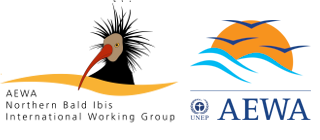Threats
| Eastern (exacerbated by already small population) | Western |
|---|---|
| Habitat degradation and destruction (breeding grounds) | Illegal building (breeding grounds) |
| Overgrazing and firewood collection (breeding grounds) | Increased greenhouse crops (breeding grounds) |
| Illegal hunting (breeding grounds and migration route) | Intensive poultry farming (close to roost sites) |
| Electrocution (Birecik and migration route) |
Critical Risk
Hunting (E)
Low sub-adult survival in the Eastern population directly correlates with the high levels of hunting along the migration route in the Arabian Peninsula – where sub-adults are known to spend more of their time, and also in Syria. In Morocco hunting mortality is more of an incidental problem due to the sedentary nature of the population – but should be watched closely, especially in advance of future reintroductions. In Central Europes release programme bird hunting is the major threat to establishing migratory populations, with 65% of losses over 10 years to 2012 due to illegal bird hunting during the autumn migration (Fritz & Unsold, 2013)
Infrastructure Development (E & W)
Hotel, tourism, constructions and leisure developments in Morocco, Syria and Turkey, and increased oil prospection in Syria are an ever increasing threat that is reducing feeding areas and leading to direct disturbance and breeding and roosting sites. Legislation and implementation is critical if these increasing pressures are to be managed. Limitations of existing legislation mean that these threats are a major concern even within the National Park of Morocco.
Potential for Disease to Spread through Breeding Populations (E & W)
Disease, contaminated food or water sources are high risk to DoI, and is heightened by the highly social nature and clustered distribution of the remaining populations. With the breeding sites in Morocco in close proximity to an area of poultry facilities and almost all of the Eastern population now within a small area in Turkey the population is highly susceptible to outbreaks (Cunningham, 2000).
Use of Locust Treatments on the Feeding Grounds (Potential, Morocco)
Locusts are a prominent feature of the DoI diet, but as agriculture increases as does the use of pesticides to control locusts. There is potential for this to cause dramatic declines in DoI numbers via secondary poisoning, however as yet work between control agencies and the National Park has helped to avert a major impact and this needs to continue unless an alternative solution is found (Cunningham, 2000).
Expansion and Intensification of Agriculture and any Switch to Glasshouse Crops (W)
Increased frequency of cultivations and increase in glasshouses on Moroccan steppe and long-interval fallow fields decreases the available feeding habitat and thus carrying capacity for DoI (Bowden et al, 2009).
Electrocution by power lines and poorly designed electricity pylons (E)
Evidence from the eastern population as well as released birds in Europe make electrocutions a major cause of the high sub-adult and adult mortality. Perching and roosting on pylons is known to be frequent in areas where cliffs or tall trees are not available, so along the migration route of the eastern population in particular (Serra et al. 2013).
Medium Risk
Depleted Food Availability and Lack of Access to Water (W)
Years of high rainfall have higher productivity. The provision of water points close to the breeding sites in Morocco showed statistical significance in improving chick survival, making measure to ensure undisturbed access to adequate food and water high priority.
Overgrazing and Firewood Collection (E)
Unsustainable grazing pressure from goats and firewood collection reduces abundance of NBI prey (Serra et al, 2008).
